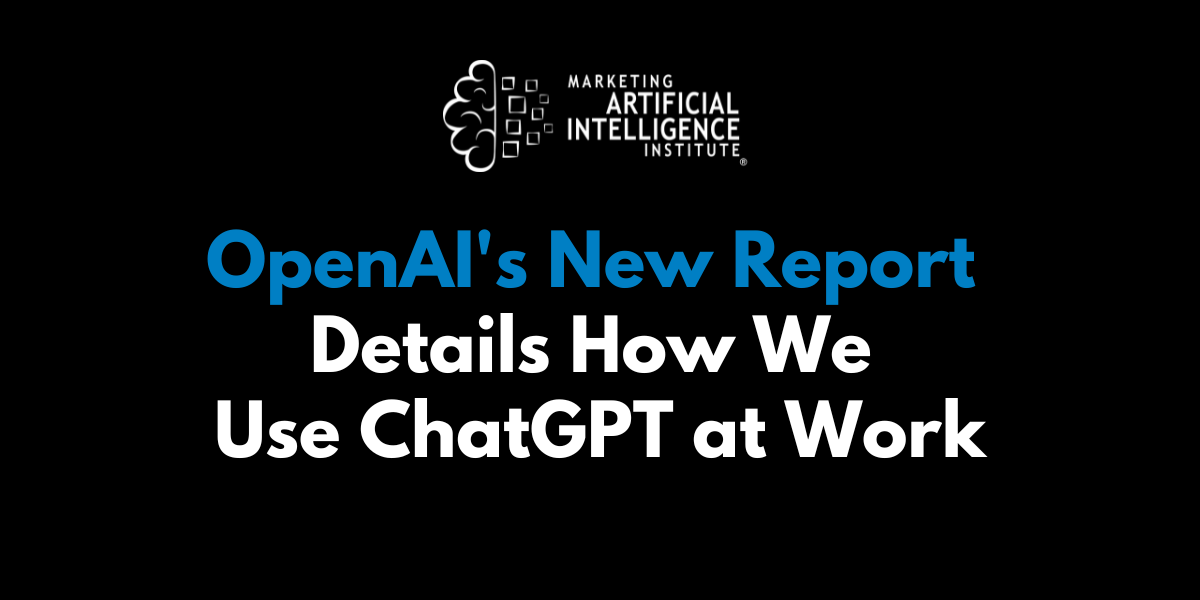OpenAI has just released a new report, "ChatGPT usage and adoption patterns at work," detailing how its flagship product has evolved from a novel consumer tool into what OpenAI calls the fastest-adopted enterprise technology in recent history.
The data, which combines anonymized usage analysis from ChatGPT and ChatGPT Enterprise with third-party industry studies, reveals that the tool is rapidly becoming a foundational operating system for work. It also highlights a growing divide between everyday users and technical "power users."
To unpack its significance, I talked to SmarterX and Marketing AI Institute founder and CEO Paul Roetzer about the report on Episode 170 of The Artificial Intelligence Show.
28% of US Workers Now Use ChatGPT at Work
The report firmly establishes ChatGPT’s massive penetration into the American workforce. According to the findings:
- Nearly a third of the US workforce is already using ChatGPT for their jobs (28%).
- Education is a strong indicator of use, with 45% of workers who have a graduate degree using the tool.
- Younger employees are leading the charge. Those aged 18 to 29 are more than twice as likely to use it for work as those over 50.
Roetzer noted the report offers a crucial new baseline, especially because of ChatGPT's wide diversity of users and use cases. The data on industry adoption, mapped from professional email domains, shows where AI has landed fastest:
- Information Technology (IT) leads with 27% of business weekly active users.
- Professional, scientific, and technical services follow at 17%.
- Finance/insurance is at 6%, and public administration and healthcare/social assistance are at 5%.
While the healthcare sector has been slower to adopt—likely due to compliance and privacy rules—the report suggests it could become a hotbed for AI as usage grows in targeted areas like clinical documentation and administrative workflows.
The Four Core Use Cases: Writing, Research, Programming, and Analysis
OpenAI’s analysis of the first 90 days of use by workers found that four main tasks overwhelmingly dominate usage:writing, research, programming, and analysis.
This trend holds across departments, but some patterns are distinct:
- Technical teams (Engineering, IT, Analytics) are the heaviest overall users, leaning on the tool for coding, research, and troubleshooting.
- Go-to-market teams (Marketing, Sales, Comms) are also major adopters, focusing primarily on writing, creative ideation, and research.
However, the data reveals a crucial disconnect between basic and advanced usage. Most employees stick to core, accessible features like search and data analysis.
The more sophisticated capabilities—like custom instructions, building their own GPTs, deep research, and reasoning models—are still the domain of what the report calls technical “power users,” primarily in R&D and engineering.
That’s important, says Roetzer, because it shows how early we are.
“The average worker does not know how to build a custom GPT,” he says. “They don't know what deep research is and they don't know the difference between a reasoning model and a chatbot.”
Why This Matters: The Rise of the AI-Enabled Generalist
The report notes that AI will embed itself into nearly every workflow, causing employees to spend less time performing tasks and more time supervising and shaping AI output.
This cross-functional reach means individuals can now handle tasks once spread across multiple departments. A product manager, for example, could use ChatGPT to analyze customer feedback, test a new feature, and then draft the legal and marketing content needed to launch it.
This confirms a trend Roetzer has long discussed: the rise of the AI-enabled generalist. AI makes it possible for anyone to add value by knowing how to ask smart questions and using these tools to find answers, then providing the layer of critical thinking needed to assess the output.
“Maybe you don’t have to be an expert in these different departments,” he says. “You don’t have to be a customer success person, for instance, to bring value to the customer success role within the organization.”
For those in the "AI bubble" who are already familiar with these tools, the report serves as a call to action:
- The need for AI literacy is becoming an explicit demand from the C-suite.
- Those on the frontier have a responsibility to educate their coworkers, friends, and family.
- The key is to bring others along, whether by building a Custom GPT for them or demonstrating a deep research project.
“I don’t know how you can’t be excited about the potential here when you realize that the knowledge we all have and are gaining every day is unparalleled in human history,” Roetzer concludes.
Mike Kaput
Mike Kaput is the Chief Content Officer at SmarterX and a leading voice on the application of AI in business. He is the co-author of Marketing Artificial Intelligence and co-host of The Artificial Intelligence Show podcast.


